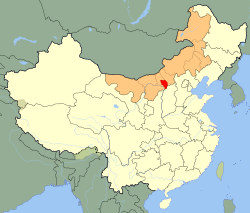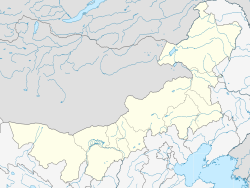Hohot
|
Hohhot 呼和浩特市 • ᠬᠥᠬᠡᠬᠣᠲᠠ |
|
|---|---|
| Prefecture-level city | |

Clockwise from top: monument of Genghis Khan, Governor of Suiyuan General, Temple of the Five Pagodas, Zhaojun Tomb.
|
|
 Hohhot (red) in Inner Mongolia (orange) |
|
| Location of the city centre in Inner Mongolia | |
| Coordinates: 40°49′N 111°39′E / 40.817°N 111.650°ECoordinates: 40°49′N 111°39′E / 40.817°N 111.650°E | |
| Country | China |
| Region | Inner Mongolia |
| County-level divisions | 10 |
| Township divisions | 116 |
| Established | 1580 |
| Government | |
| • CPC Committee Secretary | Yun Guangzhong |
| • Mayor | Li Jiexiang (李杰翔) |
| Area | |
| • Prefecture-level city | 17,186.1 km2 (6,635.6 sq mi) |
| • Urban | 2,065.1 km2 (797.3 sq mi) |
| • Metro | 2,065.1 km2 (797.3 sq mi) |
| Elevation | 1,065 m (3,494 ft) |
| Population (2012 estimate) | |
| • Prefecture-level city | 2,866,615 |
| • Density | 170/km2 (430/sq mi) |
| • Urban | 1,980,774 |
| • Urban density | 960/km2 (2,500/sq mi) |
| • Metro | 1,980,774 |
| • Metro density | 960/km2 (2,500/sq mi) |
| • Major nationalities |
Han - 87.16% Mongolian - 9.98% |
| Time zone | China Standard (UTC+8) |
| Postal code | 010000 |
| Area code(s) | 471 |
| License plate prefixes | 蒙A |
| GDP (2012) | CNY 247.6 billion (US $39.47 billion) |
| GDP per capita |
CNY 84,074 (US $13,400) |
| Local Dialect | Jin: Zhangjiakou-Hohhot dialect |
| Administrative division code | 150100 |
| ISO 3166-2 | CN-15-01 |
| Website | www |
| Hohhot | |||||||||||

Hohhot as written in Chinese
|
|||||||||||

Hohhot as written in Mongolian
|
|||||||||||
| Chinese name | |||||||||||
|---|---|---|---|---|---|---|---|---|---|---|---|
| Chinese | 呼和浩特 | ||||||||||
| Literal meaning | blue city(in Mongolian) | ||||||||||
|
|||||||||||
| Mongolian name | |||||||||||
| Mongolian Cyrillic | Хөх хот | ||||||||||
| Mongolian script | ᠬᠥᠬᠡᠬᠣᠲᠠ | ||||||||||
|
|||||||||||
| Russian name | |||||||||||
| Russian | Хух-Хото | ||||||||||
| Romanization | Chuch-Choto | ||||||||||
| Transcriptions | |
|---|---|
| Standard Mandarin | |
| Hanyu Pinyin | Hūhéhàotè |
| Yue: Cantonese | |
| Jyutping | fu1wo4hou6dak6 |
| Transcriptions | |
|---|---|
| SASM/GNC | Kökeqota |
Hohhot (Chinese: 呼和浩特; pinyin: Hūhéhàotè; Mongolian: ![]() Kökeqota; Khalkha: Хөх хот Höh hot, /xɵxˈxɔtʰ/), abbreviated Hushi (Chinese: 呼市; pinyin: Hūshì), formerly known as Kweisui (simplified Chinese: 归绥; traditional Chinese: 歸綏; pinyin: Guīsuí), is the capital of Inner Mongolia in North China, serving as the region's administrative, economic and cultural centre. Its population was 2,866,615 inhabitants at the 2010 census, of whom 1,980,774 lived in the built-up (or metro) area made up of 4 urban districts.
Kökeqota; Khalkha: Хөх хот Höh hot, /xɵxˈxɔtʰ/), abbreviated Hushi (Chinese: 呼市; pinyin: Hūshì), formerly known as Kweisui (simplified Chinese: 归绥; traditional Chinese: 歸綏; pinyin: Guīsuí), is the capital of Inner Mongolia in North China, serving as the region's administrative, economic and cultural centre. Its population was 2,866,615 inhabitants at the 2010 census, of whom 1,980,774 lived in the built-up (or metro) area made up of 4 urban districts.
The name of the city in Mongolian means "Blue City"—Kuku-Khoto in Mongolian—although it is also wrongly referred to as the "Green City." The color blue in Mongol culture is associated with the sky, eternity and purity; in Chinese, the name can be translated as Qīng Chéng (Chinese: 青城), literally, "Blue/Green City." The name has also been variously romanized as Kokotan, Kokutan, Kuku-hoton, Huhohaot'e, Huhehot, Huhhot, or Köke qota.
...
Wikipedia

